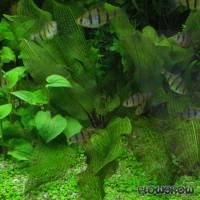



Aponogeton madagascariensis is usually found in flowing waters on the island of Madagascar. Its lacy leaf structure is unique and has made keeping this plant a challenge to hobbyists since the 1950s.
There are two varieties of Aponogeton madagascariensis, var. henkelianus and var. major with broad leaves and swallow-tailed white or yellowish flowers, which produce viable seeds after self-pollination with a brush.
The leaves of var. henkelianus have an irregular lace structure, in contrast to var. major, whose leaves are very evenly structured. Another variety readily available in the aquarium trade is var. madagascariensis, growing far larger and with smaller leaves that can grow up to a metre in length, counting the leaf stalk. The five-pointed flowers of var. madagascariensis are pink to purple. This plant cannot be propagated by self-pollination. The inflorescence of Aponogeton madagascariensis may have a diameter of up to 1.5 cm. A fully grown Aponogeton madagascariensis is too large for any tank under 500 litres volume.
All Aponogeton madagascariensis varieties prefer substrates poor in nutrients. Dark brown, spreading dead zones in the older leaves may lead to the death of the entire leaf and are an indicator for a substrate too rich in nutrients. Roots of other plants help Aponogeton madagascariensis to get a firm hold in the aquarium. However, these "helper plants" should never grow larger than Aponogeton madagascariensis or shade off its leaves. Smaller Cryptocoryne species with a compact growth are ideal for this purpose. They should be well-established in the tank before you plant the bulb of your lace plant. It should not be entirely covered in substrate as a rule.
Medium light intensity, but direct light on the plant, is a must. In addition, the Madagascar laceleaf needs CO2 fertilisation to grow well, and sufficient amounts of micro- and macronutrients. The plant is especially susceptible to iron deficiency.
Literature has it that the Madagascar laceleaf requires a resting phase where all its leaves die off. However, during this time, the tuberous root must never be allowed to dry out. The plant may or may not sprout new leaves after this phase. However, if it is kept in an aquarium under good conditions, it may grow new leaves for years without a resting phase at all. However, if it doesn't get enough CO2 and nutrients, it will still continue to sprout new leaves, however, to do so it draws on the reserves accumulated in its tuber. If they are exhausted the plant will die off. A. madagascariensis is considerably more vital when kept at temperatures not over 24 °C. At higher temps, its growth slows considerably, and the plant sprouts smaller leaves. When the temperatures get too high, it will stop growing altogether.
Like other Aponogeton species, A. madagascariensis releases its seeds in a watertight thick-walled pod which makes it possible for them to float on the water surface for 1 to 2 days. Then the pod splits and releases the seedling into the water, which in turn sinks at once, trying to root. If you prefer to plant the seedlings yourself, use quartz sand mixed with a little potting soil to make the substrate muddy and swamp-like. Under good growth conditions the leaves of the young plant should reach a length of around 10 cm after 3 to 4 months, its bulb ought to have a diameter of around 1 cm. When they have reached that size the young plants may be replanted safely.
Under sufficient light, the growth of var. henkelianus and var. major may be quite compact, which is a highly attractive feature for the middleground of large aquaria.
However, var. madagascariensis is better suited for the background and is only suitable for a tank as long as its leaves do not reach the water surface.
<a href="https://www.flowgrow.de/db/aquaticplants/aponogeton-madagascariensis-var-madagascariensis" target="_blank"><img alt="Aponogeton madagascariensis var. madagascariensis" title="Aponogeton madagascariensis var. madagascariensis" src="https://www.flowgrow.de/db/widget/aquaticplants/aponogeton-madagascariensis-var-madagascariensis" /></a>
[url=https://www.flowgrow.de/db/aquaticplants/aponogeton-madagascariensis-var-madagascariensis][img]https://www.flowgrow.de/db/widget/aquaticplants/aponogeton-madagascariensis-var-madagascariensis[/img][/url]
[widget=aquaticplants/aponogeton-madagascariensis-var-madagascariensis]Aponogeton madagascariensis var. madagascariensis[/widget]